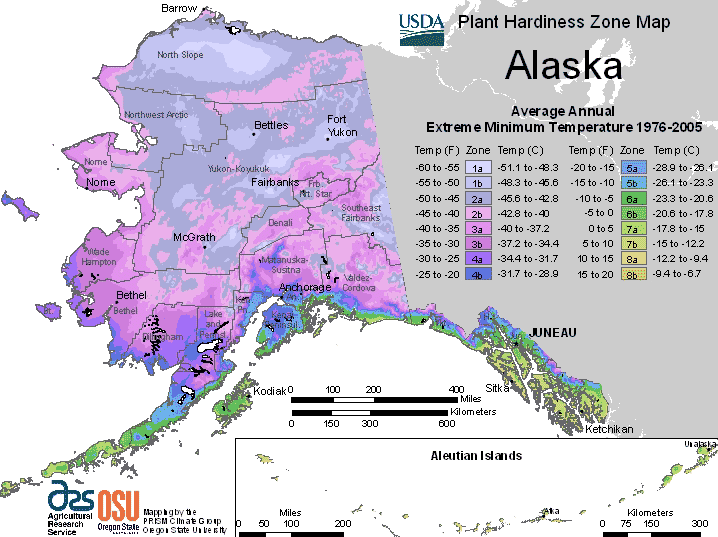
Table of Contents
Characteristics of Alaska Planting Region
Alaska’s climate and geography present both challenges and opportunities for agriculture. Its short growing season (May-Sept) and long days of daylight in summer can be beneficial for some crops but detrimental to short-day plants like strawberries. Cool temperatures favor berries and greens, but can also bring frost. High winds, snow and hail are common weather phenomena.
Challenges of Growing in Alaska
Growing plants in Alaska poses several unique challenges due to the state’s extreme climate and vast geographic diversity. The long, cold winters and short growing seasons limit the time available for plant growth and require careful selection of cold-hardy species. Additionally, the variable daylight hours, ranging from long summer days to dark winter nights, impact plant development and necessitate careful management of light exposure for certain crops.
Breathtaking Beauty in the Last Frontier: Best Plants for Alaska’s Planting Zone
Alaska, the Last Frontier, boasts stunning landscapes and a unique environment that presents both challenges and opportunities for gardening enthusiasts. The state’s vast size and diverse climates result in varying planting zones, ranging from Zone 1 in the Arctic regions to Zone 7 in the southeastern coastal areas. Selecting the right plants is crucial to create a successful garden in Alaska’s challenging climate. Here are some of the best plants to grow in Alaska’s planting zones:
1. Alaska’s State Flower: Forget-Me-Not (Myosotis alpestris): As the state flower, Forget-Me-Not is an iconic choice for Alaskan gardens. With its delicate, blue flowers, this perennial adds a touch of charm and natural beauty to the landscape.
2. Alaska Cedar (Chamaecyparis nootkatensis): This native evergreen tree is well-suited to Alaska’s colder regions. The Alaska Cedar offers year-round greenery and a pleasant fragrance, making it an excellent choice for adding privacy and windbreaks.
3. Fireweed (Chamerion angustifolium): Fireweed is a hardy perennial that thrives in Alaska’s disturbed areas. Its striking pinkish-purple spikes of flowers are a common sight in the state’s wild landscapes.
4. Arctic Willow (Salix arctica): This small, hardy shrub is well-adapted to Alaska’s arctic regions. With its silvery leaves and low-growing form, the Arctic Willow adds a unique touch to rock gardens and borders.
5. Dwarf Labrador Tea (Rhododendron tomentosum): As a native shrub, Dwarf Labrador Tea is well-suited to Alaska’s cooler climates. It offers fragrant white flowers and evergreen foliage, making it a delightful addition to woodland gardens.
6. High Bush Cranberry (Viburnum edule): High Bush Cranberry is a native shrub known for its clusters of red berries that persist into the winter. This hardy plant is an excellent choice for attracting wildlife and adding color to the garden.
7. Alaska Fern (Polystichum setiferum): This fern species is native to Alaska and offers a lush, green addition to shade gardens. Its delicate fronds bring an elegant touch to the landscape.
8. Alaska Birch (Betula neoalaskana): As a native tree, Alaska Birch is well-adapted to the state’s colder regions. Its distinctive white bark and graceful form make it a striking addition to Alaska’s landscapes.
9. Alaska Coralroot (Corallorhiza trifida): This unique and rare wildflower is native to Alaska’s forests. It lacks chlorophyll and cannot photosynthesize, relying on a symbiotic relationship with fungi for its nutrition.
10. Tundra Rose (Rosa acicularis): Tundra Rose is a native wild rose that thrives in Alaska’s arctic regions. With its simple pink flowers and rose hips, this hardy shrub adds beauty and wildlife value to the landscape.
To ensure successful gardening in Alaska, it’s crucial to consider the specific challenges posed by the state’s climate and extreme conditions. In colder regions, choosing cold-hardy plants that can withstand freezing temperatures and harsh winters is essential.
Proper soil preparation and amending can help ensure that plants have the best chance of success in Alaska’s often challenging soil conditions. Raised beds and well-drained planting areas are beneficial in areas with heavy precipitation or poor drainage.
Watering practices should be adjusted according to the specific needs of each plant and the unique microclimate of each garden. Drip irrigation and mulching are valuable techniques to conserve water and protect plants from temperature fluctuations.
Gardeners in Alaska should be prepared to protect their plants from wildlife, including moose and rabbits, which may browse on vegetation in search of food. Fencing and other protective measures can help mitigate damage to gardens.
In conclusion, Alaska’s planting zones offer a vast array of plant choices for gardeners seeking to create beautiful and resilient landscapes. From the delicate charm of Forget-Me-Nots and Fireweed to the hardiness of Alaska Cedar and Arctic Willow, the best plants for Alaska gardens celebrate the state’s natural beauty and complement its unique northern character. By embracing the challenges and opportunities presented by Alaska’s climate and employing proper care, gardening enthusiasts can enjoy flourishing gardens that thrive in the Last Frontier’s breathtaking environment.
